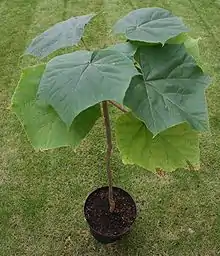Paulownia elongata
Paulownia elongata is a species of tree in the family Paulowniaceae, native to Asia.
| Paulownia elongata | |
|---|---|
 | |
| Scientific classification | |
| Kingdom: | Plantae |
| Clade: | Tracheophytes |
| Clade: | Angiosperms |
| Clade: | Eudicots |
| Clade: | Asterids |
| Order: | Lamiales |
| Family: | Paulowniaceae |
| Genus: | Paulownia |
| Species: | P. elongata |
| Binomial name | |
| Paulownia elongata | |
The plant's leaves are very large and pubescent ('fuzzy—hairy'). This species can withstand a very wide range of environmental conditions. It does not grow at higher altitudes however.
Uses
Cultivation
Paulownia elongata is cultivated as an ornamental tree for use in gardens and parks. It is selected for its purple flowers, and its shade tolerance.
Biofuel
The tree is planted and grown as feedstock for biofuel production. Due to the large quantity of biomass produced annually, it is suited for use as biofuel feedstock.
Lumber
Paulownia elongata is planted as a forestry tree producing strong, yet light, wood. It is grown for lumber in North America and China.
Commercial plantations are normally established from selected clones resulting from micropropagation.[1]
They are known to grow up to 15 feet (4.6 m) or more in the first year. It is reportedly the fastest-growing hardwood tree. Some proponents state that P. elongata plantations can reach a harvestable size in five to seven years..